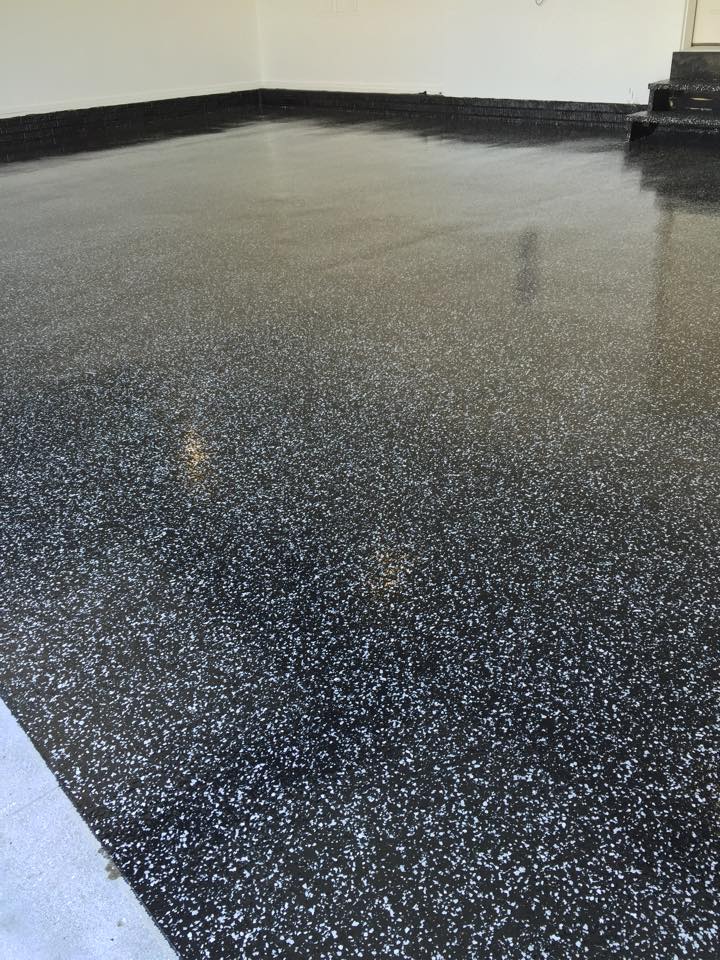
![]()
Polyaspartic and polyurea floor coatings are fairly new and have become quite popular over the last few years. These floor coatings have been the preferred choice over epoxies for many contractors primarily because of the systems ability to cure quickly and it’s durability. Polyaspartic and polyurea coatings have become particularly popular as garage floor coatings, this choice is particularly useful for anyone that cannot be without their garage for more than one day. With the fast curing time, equipment can be moved back into the garage before the day is over. When using an epoxy system the garage cannot be used for roughly five days.
There are other pros and cons to polyaspartic and polyurea coatings. Some of the additional benefits of these coatings are that they will never yellow, they have 100% U.V. stability. The finish is crystal clear that will not blush from moisture in the concrete. Similar to polyurethane, the polyaspartic and polyurea coatings will not show scratches. They can withstand a high amount of heat, so hot tire pick up is not a concern. Most applications have very little or no VOC’s and they are stain and chemical resistant. They are also known to have good flexibility which makes for a higher resistance to impact. And don’t forget the shiny high gloss finish.
Besides this amazing list of advantages of the polyaspartic and polyurea coatings they two biggest benefits are the fast cure time and the drastic temperature range that they can be applied in. Other coatings, such as epoxy, have to be in very controlled temperatures for things to go smoothly. Polyaspartics and polyurea coatings can be applied in temperatures as high as 140 degrees fahrenheit or as low as -30 degrees fahrenheit depending on the formula. Typically, these floor coatings are applied in only two coatings. First is the primer and color then the clear coat. This contributes to the curing process being so fast allowing the project to be completed in less than a day.
While polyaspartic and polyurea coatings have some great advantages, there are a few downsides to it as well. One is the cost. It typically runs $2 to $3 more than an epoxy and polyurethane system costs per square foot. It is also not something you want to do yourself, especially if you are not experienced with the product. You also want to have at least two people when applying it. The average pot life is 20 to 30 minutes depending on the formula, so you want to make sure that you know what you are doing before the application. Another con is that the materials needed cost about two times as much as epoxy. It’s also important to know that polyaspartics are not all the same like epoxy.
When fully cured water and humidity is not an issue for polyaspartics and polyurea coatings, however, it will cause it to cure faster if installed in a humid environment. Another thing to consider when choosing a garage coating is what kind of materials and chemicals will get on the floor. Polyaspartics don’t tolerate battery acid like epoxies and polyurethane does. Polyaspartics and polyureas are also very slippery when wet, so it helps to have flakes added for texture. A slip resistant aggregate can also be added to the top coat to help prevent slippage.
So, as with anything, there are pro’s and cons to polyaspartic and polyurea coatings. It really depends on the demands of the environment for what coating to choose. If you are interested in installing a floor coating and would like more information about the different types feel free to give us a call.
There are so many creative and custom options for finishing concrete, but first and foremost important is the concrete itself. At Custom Concrete Creations we have state of the art equipment and a properly trained team with years of experience. Custom Concrete Creations is a premier contractor serving the Omaha area as well at the Midwest. Give us a call or send us an email for your custom concrete finishing needs today!
